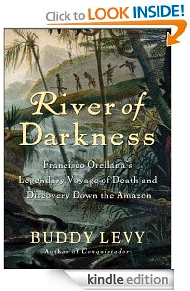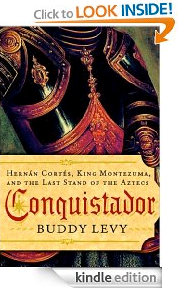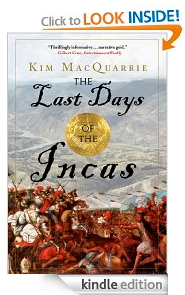-
River of Darkness
Posted by Lois Seelandt on 3/1/2021 2:00:00 PM From the acclaimed author of Conquistador comes this thrilling account of one of history’s greatest adventures of discovery. With cinematic immediacy and meticulous attention to historical detail, here is the true story of a legendary sixteenth-century explorer and his death-defying navigation of the Amazon—river of darkness, pathway to gold.
From the acclaimed author of Conquistador comes this thrilling account of one of history’s greatest adventures of discovery. With cinematic immediacy and meticulous attention to historical detail, here is the true story of a legendary sixteenth-century explorer and his death-defying navigation of the Amazon—river of darkness, pathway to gold.
In 1541, the brutal conquistador Gonzalo Pizarro and his well-born lieutenant Francisco Orellana set off from Quito in search of La Canela, South America’s rumored Land of Cinnamon, and the fabled El Dorado, “the golden man.” Driving an enormous retinue of mercenaries, enslaved natives, horses, hunting dogs, and other animals across the Andes, they watched their proud expedition begin to disintegrate even before they descended into the nightmarish jungle, following the course of a powerful river. Soon hopelessly lost in the swampy labyrinth, their numbers diminishing daily through disease, starvation, and Indian attacks, Pizarro and Orellana made a fateful decision to separate. While Pizarro eventually returned home barefoot and in rags, Orellana and fifty-seven men, in a few fragile craft, continued downriver into the unknown reaches of the mighty Amazon, serenaded by native war drums and the eerie cries of exotic predators. Theirs would be the greater glory.
Interweaving eyewitness accounts of the quest with newly uncovered details, Buddy Levy reconstructs the seminal journey that has electrified adventurers ever since, as Orellana became the first European to navigate and explore the entire length of the world’s largest river. Levy gives a long-overdue account of the native populations—some peaceful and welcoming, offering sustenance and life-saving guidance, others ferociously hostile, subjecting the invaders to gauntlets of unremitting attack and intimations of terrifying rituals. And here is the Amazon itself, a powerful presence whose every twist and turn held the promise of new wonders both natural and man-made, as well as the ever-present risk of death—a river that would hold Orellana in its irresistible embrace to the end of his life.Overflowing with violence and beauty, nobility and tragedy, River of Darkness is both riveting history and a breathtaking adventure that will sweep readers along on an epic voyage unlike any other.Comments (-1)(0) -
Conquistador
Posted by Lois Seelandt on 1/4/2021 8:00:00 AM In an astonishing work of scholarship that reads like an adventure thriller, historian Buddy Levy records the last days of the Aztec empire and the two men at the center of an epic clash of cultures.
In an astonishing work of scholarship that reads like an adventure thriller, historian Buddy Levy records the last days of the Aztec empire and the two men at the center of an epic clash of cultures.
“I and my companions suffer from a disease of the heart which can be cured only with gold.” —Hernán Cortés
It was a moment unique in human history, the face-to-face meeting between two men from civilizations a world apart. Only one would survive the encounter. In 1519, Hernán Cortés arrived on the shores of Mexico with a roughshod crew of adventurers and the intent to expand the Spanish empire. Along the way, this brash and roguish conquistador schemed to convert the native inhabitants to Catholicism and carry off a fortune in gold. That he saw nothing paradoxical in his intentions is one of the most remarkable—and tragic—aspects of this unforgettable story of conquest.In Tenochtitlán, the famed City of Dreams, Cortés met his Aztec counterpart, Montezuma: king, divinity, ruler of fifteen million people, and commander of the most powerful military machine in the Americas. Yet in less than two years, Cortés defeated the entire Aztec nation in one of the most astonishing military campaigns ever waged. Sometimes outnumbered in battle thousands-to-one, Cortés repeatedly beat seemingly impossible odds. Buddy Levy meticulously researches the mix of cunning, courage, brutality, superstition, and finally disease that enabled Cortés and his men to survive.Comments (-1)(0) -
The Last Days of the Incas
Posted by Lois Seelandt on 10/1/2020 8:00:00 AM In 1532, the fifty-four-year-old Spanish conquistador Francisco Pizarro led a force of 167 men, including his four brothers, to the shores of Peru. Unbeknownst to the Spaniards, the Inca rulers of Peru had just fought a bloody civil war in which the emperor Atahualpa had defeated his brother Huascar. Pizarro and his men soon clashed with Atahualpa and a huge force of Inca warriors at the Battle of Cajamarca. Despite being outnumbered by more than two hundred to one, the Spaniards prevailed -- due largely to their horses, their steel armor and swords, and their tactic of surprise. They captured and imprisoned Atahualpa. Although the Inca emperor paid an enormous ransom in gold, the Spaniards executed him anyway. The following year, the Spaniards seized the Inca capital of Cuzco, completing their conquest of the largest native empire the New World has ever known. Peru was now a Spanish colony, and the conquistadors were wealthy beyond their wildest dreams.
In 1532, the fifty-four-year-old Spanish conquistador Francisco Pizarro led a force of 167 men, including his four brothers, to the shores of Peru. Unbeknownst to the Spaniards, the Inca rulers of Peru had just fought a bloody civil war in which the emperor Atahualpa had defeated his brother Huascar. Pizarro and his men soon clashed with Atahualpa and a huge force of Inca warriors at the Battle of Cajamarca. Despite being outnumbered by more than two hundred to one, the Spaniards prevailed -- due largely to their horses, their steel armor and swords, and their tactic of surprise. They captured and imprisoned Atahualpa. Although the Inca emperor paid an enormous ransom in gold, the Spaniards executed him anyway. The following year, the Spaniards seized the Inca capital of Cuzco, completing their conquest of the largest native empire the New World has ever known. Peru was now a Spanish colony, and the conquistadors were wealthy beyond their wildest dreams.But the Incas did not submit willingly. A young Inca emperor, the brother of Atahualpa, soon led a massive rebellion against the Spaniards, inflicting heavy casualties and nearly wiping out the conquerors. Eventually, however, Pizarro and his men forced the emperor to abandon the Andes and flee to the Amazon. There, he established a hidden capital, called Vilcabamba. Although the Incas fought a deadly, thirty-six-year-long guerrilla war, the Spanish ultimately captured the last Inca emperor and vanquished the native resistance.
Kim MacQuarrie lived in Peru for five years and became fascinated by the Incas and the history of the Spanish conquest. Drawing on both native and Spanish chronicles, he vividly describes the dramatic story of the conquest, with all its savagery and suspense. MacQuarrie also relates the story of the modern search for Vilcabamba, of how Machu Picchu was discovered, and of how a trio of colorful American explorers only recently discovered the lost Inca capital of Vilcabamba, hidden for centuries in the Amazon.
This authoritative, exciting history is among the most powerful and important accounts of the culture of the South American Indians and the Spanish Conquest.
Comments (-1)(0) -
1491: New Revelations of the Americas Before Columbus
Posted by Lois Seelandt on 9/3/2020 8:00:00 AM In this groundbreaking work of science, history, and archaeology, Charles C. Mann radically alters our understanding of the Americas before the arrival of Columbus in 1492.
In this groundbreaking work of science, history, and archaeology, Charles C. Mann radically alters our understanding of the Americas before the arrival of Columbus in 1492.
Contrary to what so many Americans learn in school, the pre-Columbian Indians were not sparsely settled in a pristine wilderness; rather, there were huge numbers of Indians who actively molded and influenced the land around them. The astonishing Aztec capital of Tenochtitlan had running water and immaculately clean streets, and was larger than any contemporary European city. Mexican cultures created corn in a specialized breeding process that it has been called man’s first feat of genetic engineering. Indeed, Indians were not living lightly on the land but were landscaping and manipulating their world in ways that we are only now beginning to understand. Challenging and surprising, this a trans-formative new look at a rich and fascinating world we only thought we knew.Comments (-1)(0)


